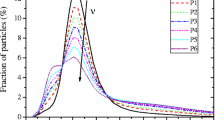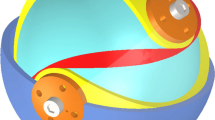Abstract
The influence of the remnant magnetization of the soft magnetic particulates, used as a dispersed phase, on the redispersibility of magnetorheological (MR) fluids is discussed. Calculations of the magnetic interaction energy showed that for 33-vol% MR fluids based on particles of iron (∼6 μm), manganese zinc ferrite (∼2.3 μm), and nickel zinc ferrite (∼2.1 μm), the ratios of the magnetic interaction energy to the thermal energy were 161,000, 6400, and 3900, respectively. These calculations showed that even the seemingly small levels of remnant magnetization, associated with particulates employed in MR fluids, introduced significant dipole–dipole interparticle interactions. It is proposed that this interaction causes most MR fluids to show a tendency for “cake formation,” which makes it difficult to redisperse these fluids. Our modeling presented here also suggests practical strategies to enhance the redispersibility of MR fluids.
Similar content being viewed by others
References
J.M. Ginder, in Encyclopedia of Applied Physics, edited by E. Immergut (VCH, New York, 1996), Vol. 16, p. 487.
P.P. Phulé, MRS Bull. 23(8), 23 (1998).
P.P. Phulé and J.M. Ginder, Intl. J. Mod. Phys. (in press).
J. Rabinow, AIEE Trans. 67, p. 1308 (1948).
J. Rabinow, U.S. Patent No. 2 675 360 (1951).
J. Rabinow, SAE National Transportation Meeting, Cleveland, OH (1949).
M. Ozaki, T. Egami, N. Sugiyama, and E. Matijevic, J. Coll. Interface Sci. 125(1), p. 212 (1988).
A.P. Chacko and D.E. Nikles, IEEE Trans. Magnetics 32, 4043 (1996).
P.P. Phulé, A.D. Jatkar, and J.M. Ginder, in Materials for Smart Systems, MRS Proc. Vol. 459, edited by E.P. George, R. Gotthardt, K. Otsuka, S. Trolier-McKinstry, and M. Wun Fogle, (Mat. Res. Soc., 1997), p. 99.
L. Zhang and A. Manthiram, IEEE Trans. 32(5), 4481 (1996).
G.J. Muench, S. Arajs, and E. Matijevic, J. Appl. Phys. 52, 2493 (1981).
G. Bate, in Concise Encyclopedia of Magnetic and Superconducting Materials, edited by. J. Evettes, (Pergamon Press, Elmsford, NY, 1992), p. 247.
E. Lemaire, A. Meunier, G. Bossis, J. Liu, D. Felt, P. Bashtovoi, and N. Matoussevitch, J. Rheol. 39, 1011 (1995).
G. Bossis and E. Lemaire, J. Rheol. 35, 1345 (1991).
R.E. Rosensweig in Concise Encyclopedia of Magnetic and Superconducting Materials, edited by J. Evettes (Pergamon Press Inc., Elmsford, NY, 1992), p. 141.
V.E. Fertman, Magnetic Fluids Guidebook: Properties and Applications (Hemisphere Publishing Corp., New York, 1990).
Cl. Kormann, L. Laun, and G. Klett, in Electrorheological Fluids, Magnetorheological Suspensions, and Associated Technology, edited by W.A. Bullough (World Scientific, Sheffield, UK, 1996), p. 362.
W.I. Kordonsky and S.D. Jacobs, in Electrorheological Fluids, Magnetorheological Suspensions, and Associated Technology, edited by W.A. Bullough (World Scientific, Sheffield, UK, 1996), p. 1.
R. Rosensweig, Ferrohydrodyanmics (Dover Publications, Inc., New York, 1985).
Author information
Authors and Affiliations
Rights and permissions
About this article
Cite this article
Phulé, P.P., Mihalcin, M.P. & Genc, S. The role of the dispersed-phase remnant magnetization on the redispersibility of magnetorheological fluids. Journal of Materials Research 14, 3037–3041 (1999). https://doi.org/10.1557/JMR.1999.0407
Received:
Accepted:
Published:
Issue Date:
DOI: https://doi.org/10.1557/JMR.1999.0407




